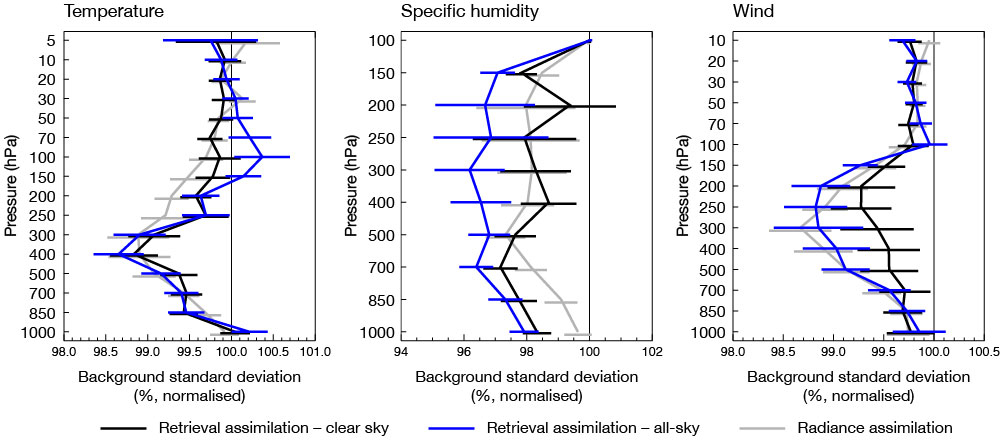We are soon entering the era of next-generation hyperspectral infrared (IR) instruments, such as the Infrared Atmospheric Sounding Interferometer – New Generation (IASI-NG) and the Meteosat Third Generation Infrared Sounder (MTG-IRS). These instruments will give us more detailed measurements of the state of the atmosphere spatially and temporally, but they will also significantly increase the data amounts to be handled. Radiance assimilation is still the preferred approach to constrain numerical weather prediction (NWP) model analysis, but at the same time there is also increased interest in alternative ways to use satellite observations. This includes direct assimilation of retrieved atmospheric parameters. Here we focus on recent joint investigations between EUMETSAT and ECMWF to assess the potential of directly assimilating retrieved temperature and humidity from IASI in ECMWF’s Integrated Forecasting System (IFS). While ECMWF is not currently planning to assimilate the retrievals in operations, the results are very encouraging, with particular added value for humidity forecasts. They also provide interesting insights for ECMWF’s Member and Co‑operating States.
All-sky temperature and humidity retrievals
The piecewise linear regression (PWLR) all‑sky machine learning retrieval approach has been the cornerstone in EUMETSAT's operational IASI retrieval processing since 2010 and forms the baseline for future missions. For this study, we have used retrievals exploiting IASI without its microwave sounder companions as a proxy for MTG-IRS. The training set consists of about 68 million IASI spectra from May 2019 to April 2020, paired with collocated temperature and humidity profiles from operational ECMWF analyses and forecasts.
The PWLR retrieval method is based on linear regression. In order to capture the non-linear relationship between the inputs and the outputs better, the input space is divided into several classes. For each of these classes, a separate set of linear regression coefficients is computed from the corresponding subset of the training set, such that overall a piecewise linear function from the input space into the output space is obtained.
The retrievals are provided as principal component (PC) scores together with scene-dependent observation operators. These operators guarantee that only the vertical structures which the sounders can resolve are conveyed into the model and that finer model structures are preserved. Use of the scene-dependent observation operators has been the key in achieving a positive impact from the retrieval assimilation.
Impact assessment in the ECMWF system
The impact of temperature and humidity retrievals from Metop-C IASI has been tested in IFS Cycle 48r1. Depleted observing system experiments are a widely used method to emphasise the impact originating from new data. The focus in the assimilation experiments has been on retrievals over sea, as they have high and homogeneous quality.
The baseline experiment uses conventional and AMSU‑A observations. In the test experiments, either IASI radiances or retrievals are assimilated on top of the baseline experiment. IASI radiances are currently used from channels diagnosed cloud free. This includes completely clear situations and channels which are diagnosed clear above a cloudy scene. The retrieval assimilation has been tested in completely clear situations and in all-sky scenes, including both clear and cloud-affected areas, using different thresholds for the cloud information provided with the data.

The impact on temperature, humidity and wind forecasts is clearly positive in all depleted system assimilation experiments. The impact on short-range forecasts is shown in the figure in terms of normalised change in background departure standard deviations for radiosonde observations. In clear-sky scenes (black line), the retrieval assimilation brings very similar information into the system to that of the radiance assimilation (grey line). For temperature and wind the impact from retrieval assimilation is somewhat smaller in magnitude than from the radiance assimilation in the upper atmosphere. For humidity, the impact of retrievals is slightly larger in the lowest 3 km (up to about 700 hPa). When the retrievals are assimilated in all-sky scenes (blue line) the magnitude of the impact becomes comparable for temperature and winds. For humidity, the retrieval assimilation even outperforms the radiance assimilation impact. However, for temperature forecasts some degradation is seen above 150 hPa in the all‑sky experiment. This is the first time that such a strong positive impact is seen from a retrieval assimilation.
The experiments have been repeated in the full observing system. As expected, the signal is weaker than in depleted observing system experiments. The results still indicate positive impact on humidity, while the impact on temperature is mainly neutral when the retrievals are used in clear scenes. In all‑sky experimentation, the temperature forecasts are currently degraded, which would require further investigations and the fine-tuning of the quality control and observation errors used.
Concluding remarks
The results in the depleted observing system are very positive and robust and the all‑sky experimentation is indicating comparable or even better impact than radiance assimilation, especially for humidity. This is probably because of using more humidity-sensitive channels, and overall more observations, in all‑sky retrieval assimilation than in the radiance assimilation. In full observing system experimentation, the main benefits are currently coming from the humidity retrievals, and further work to consolidate the results would be needed.
